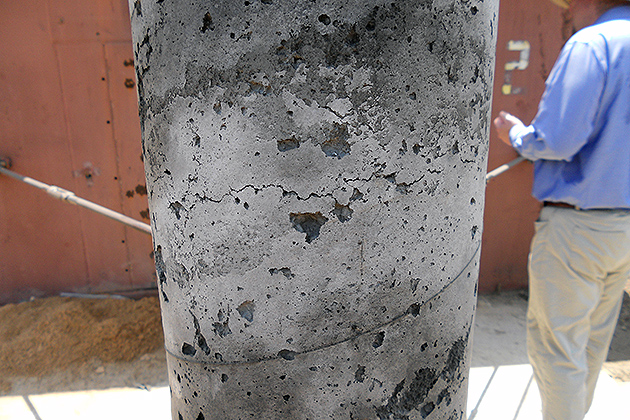Researchers in the Department of Civil and Environmental Engineering are testing a new style of bridge column construction with an eye to developing columns capable of withstanding such events as earthquakes, explosions, and fires. Assistant Professor Arash Esmaili Zaghi and Associate Professor Richard Christenson are leading the project with first-year master’s degree student Alicia Echevarria.

Across the U.S., more than 600,000 bridges link travelers to millions of roadway miles, forming a critical part of the nation’s infrastructure. Because bridges are typically more vulnerable than roadways to damage caused by natural and man-made hazards, they are also of interest to the U.S. Department of Homeland Security, which funds cutting-edge research in various aspects of structural integrity testing and blast-resistant structural design.
With the aim of developing next-generation bridge columns capable of supporting vehicular traffic even after exposure to extreme blasts, the research team is conducting a series of large-scale tests that will provide data on conventional concrete columns as well as columns of a promising alternative design.

While most U.S. bridge columns rely on a traditional reinforced concrete (RC) design, Echevarria and Zaghi are studying a new column design that features concrete-filled, fiber-reinforced polymer tubes (CFFT). This specialized piping system has been used in the oil and gas industry for years, where they have proven extremely durable in varied environmental conditions.
Echevarria and Zaghi designed and constructed 10 one-fifth-scale test bridge columns, five each of the conventional RC design and the proposed CFFT construction. Over the course of eight weeks earlier this year, the research team worked with the U.S. Army Corps of Engineers’ Engineering Research and Development Center in Mississippi to run explosive testing on four of the columns – two of the conventional design and two of the experimental design.
According to Zaghi, the experimental columns showed no outward signs of damage, even after having been exposed to a significant level of explosives. While Echevarria begins to process the data, a second group of four columns will soon be shipped to another laboratory in upstate New York, where they will undergo lengthy exposure to extreme fire.

Of the 10 original columns, one each of the conventional and experimental constructions will serve as controls; these columns were not exposed to explosives or fire and will provide important benchmark data.
Into the Structural Research Lab
Once the fire tests are complete, the research team will subject all 10 columns to further testing in the Structural Research Laboratory on the Storrs campus. Here, each column will be gradually pushed on its ends to the point of failure, when the column is crushed. The data gathered from this test and the previous tests will help the team determine how well the next-generation column design withstands extreme events in comparison to the traditional RC columns.
In addition, the researchers are exploring techniques that could one day enable officials to assess damaged bridge columns quickly and reliably, in order to determine a bridge’s ability to carry traffic safely after it has sustained damage. Supervised by Christenson, the team is working on a special hammer that first responders could use after an explosion, fire, or earthquake to decide whether a bridge is safe enough to continue carrying traffic.
The experimental column design, researchers say, could offer advantages beyond superior strength and resilience, including the fact that they can be constructed more quickly than conventional bridge columns.
The research is supported by UConn’s HS-STEM Program, which is administered by the Center for Resilient Transportation Infrastructure and funded by the U.S. Department of Homeland Security Science and Technology Directorate/Office of University Programs.



